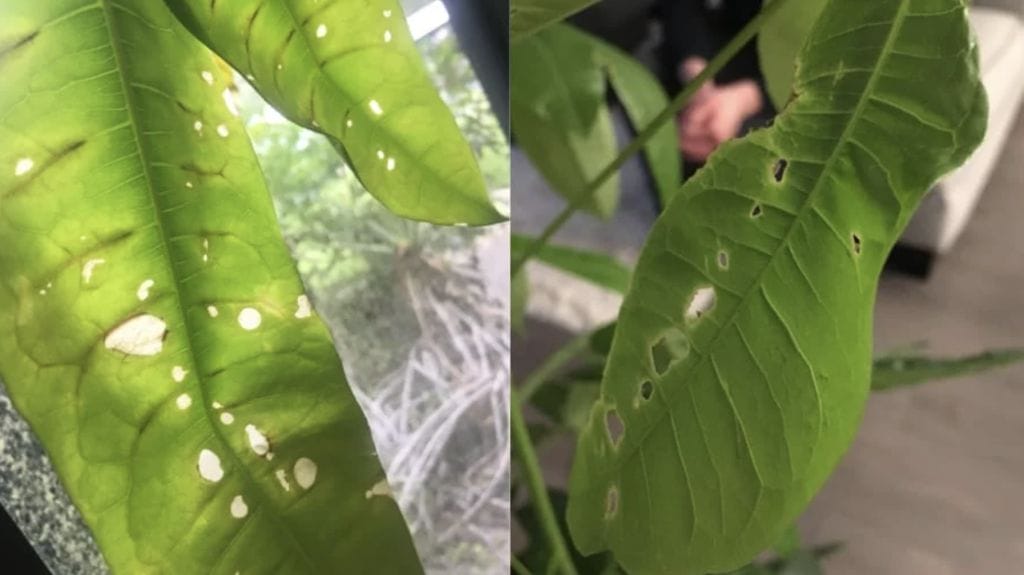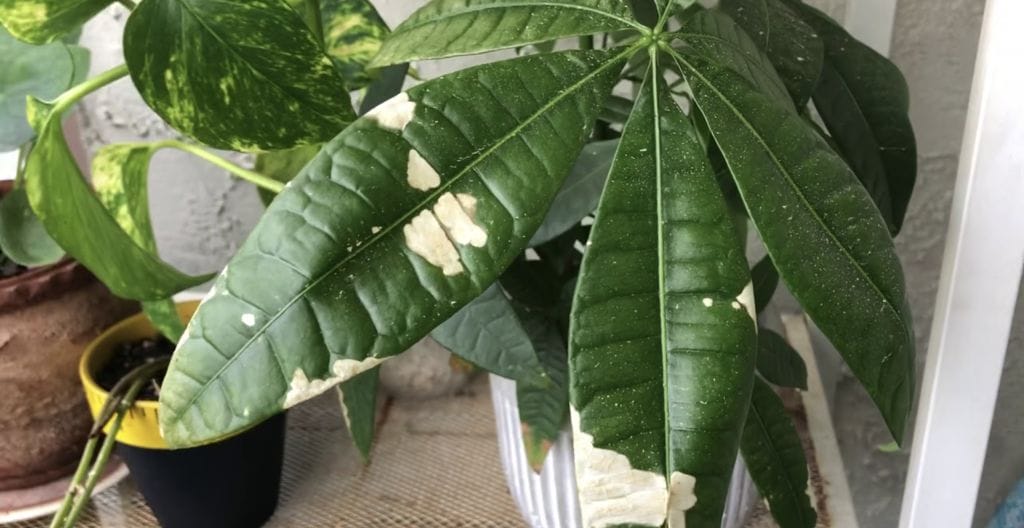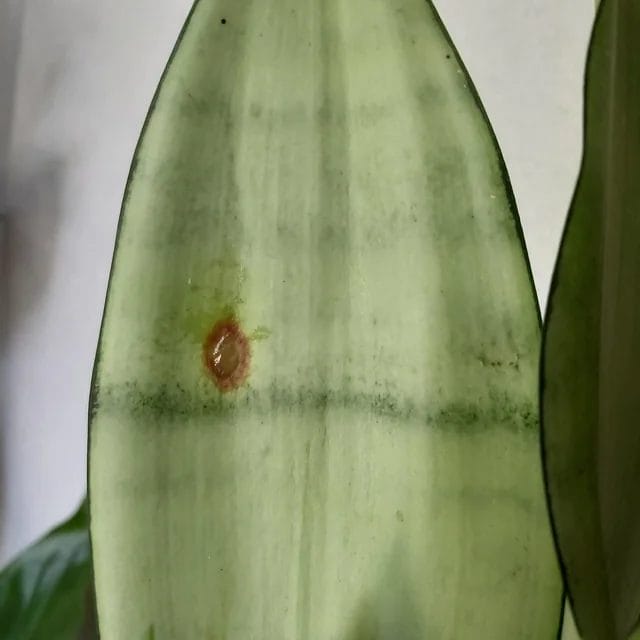Money Tree Holes in Leaves: Causes and Solutions

The Money Tree (Pachira aquatica) is a popular houseplant, symbolizing wealth and good fortune. However, one unfortunate issue that many plant enthusiasts face is the appearance of holes in the leaves. Understanding the causes of these holes is essential for maintaining the health and beauty of your beloved money tree.
Various factors contribute to the occurrence of leaf holes, including pest infestations, diseases, and inadequate care conditions. By recognizing the symptoms and causes, you can effectively troubleshoot the problem and find the most suitable solution to prevent further damage to your plant.
Causes of Holes in Money Tree Leaves

Pest Infestation
One of the leading causes of holes in your money tree leaves is pests. Aphids, mealybugs, and spider mites are common culprits that feed on the sap of your plant, causing damage. Scale insects, caterpillars, and Japanese beetles can also cause holes in your money tree leaves. To identify and eliminate these pests, inspect your plant regularly and consider using methods such as neem oil or insecticidal soap.
Disease
Fungal and bacterial diseases can also lead to holes in your money tree leaves. Common diseases include Alternaria, anthracnose, bacterial leaf spot, and Phytophthora blight. The appearance of discolored spots on the leaves may indicate disease. To treat these issues, apply a fungicide and ensure your plant has proper air circulation and appropriate watering habits to prevent further spread.
Physical Damage
Physical damage can be another cause for holes in your money tree leaves. Rough handling during transport or pruning can break leaves, leaving them susceptible to infection or pests. Ensure your money tree is protected from strong winds, and handle it carefully when repotting or pruning.
Boron Deficiency
Boron deficiency may also lead to holes in your money tree leaves. Boron is a vital nutrient for plant development. Its deficiency can cause poor root growth and leave formation challenges. To address this issue, supplement your money tree’s soil with a balanced fertilizer containing trace elements like boron.
Excess Fertilizer
Excess fertilization can cause a rapid intake of minerals, leaving your money tree leaves susceptible to damage and holes. Over-fertilized plants can attract pests and are more prone to diseases. Be mindful of your money tree’s fertilizing needs and avoid over-fertilizing by following the recommended application rates and intervals.
Prevention and Treatment
Caring for Money Trees
To maintain the health of your Pachira aquatica and prevent holes in its leaves, it’s essential to provide optimal growth conditions. Ensure your money tree receives 6-8 hours of indirect sunlight each day. Watering should be consistent but avoid overwatering and underwatering. Keep the soil moisture level even by allowing the top 2-3 inches to dry out before watering again.
Pay attention to temperature and humidity as well. Your money tree prefers a temperature range of 60-80 degrees Fahrenheit and a humidity level of at least 50%. You can increase the humidity by placing the plant on a tray of water and pebbles or using a humidifier.
Fertilize your money tree using an all-purpose fertilizer twice a month during the growing season. Make sure to plant your tree in well-draining, peat-based potting soil to prevent excess water accumulation.
Removing Pests
Pests are one of the leading causes of holes in your money tree leaves. To eliminate pests, follow these steps:
- Inspect your money tree regularly for signs of infestation, such as small insects, webs, or honeydew.
- If you find pests, remove them with a jet of water or use a cotton swab dipped in rubbing alcohol to physically remove them from the plant.
- For persistent infestations, consider using natural insecticidal soaps or neem oil to kill the pests without harming your plant.
By diligently checking your plant and promptly addressing any signs of pests, you can prevent holes and maintain the overall health of your money tree.
Treating Diseases
Diseases can also lead to holes in money tree leaves. Common diseases include leaf spot, powdery mildew, and anthracnose. To treat and prevent diseases:
- Keep your plant in a well-ventilated area and avoid overcrowding with other plants.
- Remove and dispose of any infected leaves to prevent the spread of disease.
- Apply a fungicide if necessary, following the manufacturer’s instructions.
By following these guidelines, you can effectively prevent and treat holes in your money tree leaves and ensure your plant remains healthy and thriving.
Specific Pest Management and Treatment

Mealybugs and Mealy Bug Control
Mealybugs are one of those pests that can cause holes in your Money Tree leaves. These tiny, white, cotton-like insects can be easily identified by their waxy, cottony appearance. They feed on plant sap, causing noticeable damage to your Money Tree leaves.
To control mealybugs, you can use a cotton swab dipped in alcohol to remove them from your Money Tree leaves. When applying alcohol, be gentle to avoid damaging the plant further. After wiping them off, rinse your leaves with water to remove any remaining residue. Regularly monitor your plants to keep the mealybug population under control.
Neem Oil for Pest Control
Neem oil is a great natural remedy for controlling various pests that infest your Money Tree, including mealybugs. It acts as a natural insecticide, repelling and killing pests upon contact. To use neem oil:
- Mix a few drops of neem oil with water in a spray bottle.
- Apply the mixture to the infested areas of your Money Tree.
- Repeat the process every few days until you observe a significant reduction in pest population.
Ensure proper ventilation while applying neem oil to avoid any respiratory issues.
Natural Pest Management Methods
- Honeydew control: Mealybugs release a substance called honeydew, which attracts other pests and encourages mold growth. Maintaining cleanliness around your plant will help keep honeydew buildup in check.
- Ladybugs: These beneficial insects are natural predators of pests like mealybugs and aphids. Introducing ladybugs in your garden or indoor plant area can help keep the pest population under control.
- Bacillus thuringiensis: This is a soil-dwelling bacterium that acts as a natural pesticide. Bacillus Thuringiensis is particularly effective against caterpillars and certain beetle species.
- Cotton wool: If you find mealybugs on your Money Tree leaves, you can also use cotton wool soaked in soapy water to wipe the leaves and remove the insects gently.
Using these natural pest management methods, you can effectively control and prevent mealybugs and other pests from damaging your Money Tree leaves, ensuring a healthy and thriving plant.
Disease Management and Treatment

Leaf Spot Disease
Leaf spot disease is a common issue in money trees, causing yellowing and drooping of the leaves. This fungal disease can result in holes appearing in the leaves due to degradation of tissue. To prevent and treat leaf spot disease, remove any infected leaves and avoid overhead watering to keep the foliage dry. If the infection persists, you can apply a copper-based fungicide to help control the spread of the disease.
Root Rot
Root rot is another common cause of holes in money tree leaves. This fungal disease often occurs when the roots are in a damp environment for an extended period, leading to their decay. To avoid root rot, ensure proper drainage by using well-draining soil and a pot with drainage holes. Water your money tree only when the top inch of soil becomes dry to avoid overwatering. Remove the affected roots and repot the plant in fresh soil if you notice signs of root rot, such as yellowing and drooping leaves.
Fungus
There are several types of fungi that can affect money trees, including powdery mildew, which covers the leaves in a powdery white substance. This can make the leaves turn yellow and eventually lead to holes in the foliage. Fungal diseases thrive in damp, poorly ventilated conditions, so it’s essential to maintain adequate air circulation and avoid over-watering to prevent their growth.
To treat fungal diseases like powdery mildew, remove all affected leaves and apply a fungicide specifically designed for the type of fungus causing the problem. Additionally, ensure your money tree is receiving adequate light to keep its energy levels high, which can help it resist infections.
Remember to monitor the health of your money tree regularly, promptly address any signs of disease, and maintain proper growing conditions to minimize the chances of holes appearing in the leaves.
Additional Care Tips
Avoiding Physical Damage
To keep your money tree healthy and prevent leaves from curling or developing black spots, handling it with care is essential. Be gentle when moving or pruning the tree to avoid causing physical damage to the foliage. Ensure proper safety precautions are taken, such as wearing gloves when handling the sap, as it may be an irritant.
The lack of water might cause leaves to curl or develop black spots during winter. To prevent this, maintain a consistent watering schedule, allowing the top few inches of soil to dry before watering again. Adequate humidity is also crucial in maintaining your money tree’s health, so consider using a humidifier or placing the plant on a tray filled with pebbles and water.
Knowing When to Repot
Repotting is an essential aspect of money tree care. As your tree grows, its current pot might become too small or crowded, leading to limited water and nutrient absorption. Signs that you may need to repot your money tree include:
- Roots circling or growing out of the drainage holes
- Water draining too quickly or pooling on the surface
- Stunted growth or rapid yellowing of leaves.
When it’s time to repot, choose a slightly larger pot with good drainage to accommodate your money tree’s growth. Repotting is best done during the growing season, typically in spring or early summer. By repotting your money tree, you are ensuring its continued growth and health, ultimately preventing issues such as leaf curling or black spots.






